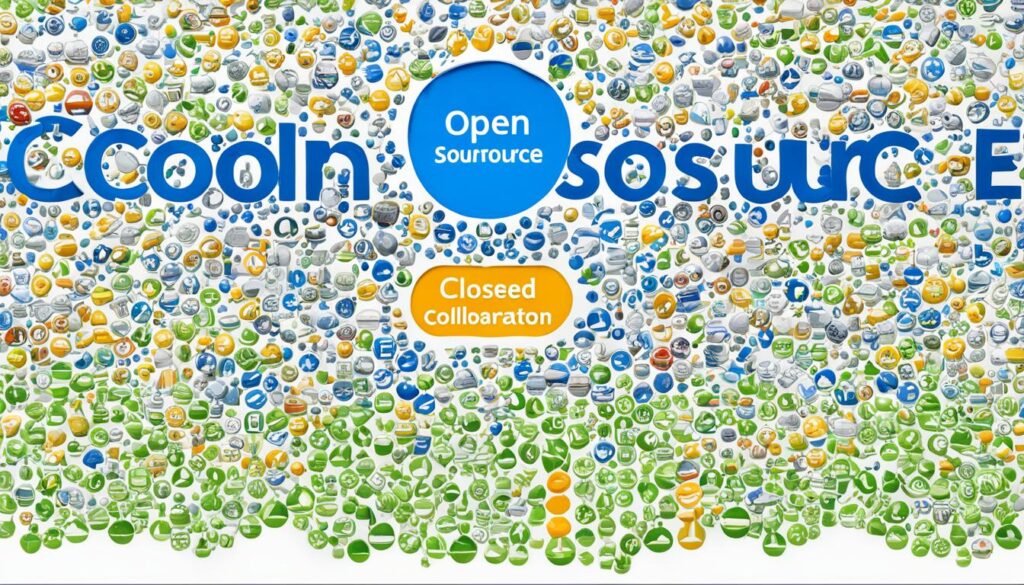Welcome to our comprehensive guide on open source tools and software. In this article, we will explore the concept of open source, its history, and its significance in the world of technology. Moreover, we will discuss the differences between open source and closed source software, as well as the importance of ensuring open source software security. So, let’s dive in!
Open source software refers to software projects that allow users to freely access, modify, and distribute the source code. It originated from an ideological movement founded by Richard Stallman in 1983 and led to the formation of the Open Source Initiative (OSI) in 1998. Open source code is stored in public repositories and comes with various licenses such as MIT, GPL, Apache, and BSD. Some popular examples of open source software include GNU/Linux, Mozilla Firefox, VLC media player, and Apache web server.
While open source software is not bug-free, its broad community of contributors helps identify and fix issues more quickly. Open source software differs from closed source software in terms of price, customization, user-friendliness, after-sales support, security, and more. It offers numerous benefits such as flexibility, stability, ingenuity, and the opportunity for continuous learning and collaboration.
Key Takeaways:
- Open source software allows users to freely access, modify, and distribute the source code.
- Open source software is supported by a community of contributors.
- Examples of open source software include GNU/Linux, Mozilla Firefox, VLC media player, and Apache web server.
- Open source software offers benefits such as flexibility, stability, and continuous learning opportunities.
- Proper open source risk management is crucial for organizations using open source software.
Now that we have gained a basic understanding of open source tools and software, let’s delve deeper into their history and significance in the next section.
The History and Importance of Open Source
The history of open source software traces back to the early 1980s when Richard Stallman, a software developer and advocate, pioneered the concept of making source code freely available. Stallman believed in the importance of software accessibility, which led him to release free code under the GNU Public License.
This ideological movement gained momentum and eventually led to the formation of the Open Source Initiative (OSI) in 1998. The OSI serves as a platform to promote and protect open source software and the communities surrounding it. It advocates for the use of open source licenses, such as the MIT, GPL, Apache, and BSD licenses, that allow users to access, modify, and distribute source code freely.
Open source software operates through public repositories where developers contribute their work and anyone can access and use the code. This collaborative approach has resulted in the development of numerous successful open source projects.
Some notable examples of open source software include:
- GNU/Linux: An open source operating system
- Mozilla Firefox: An open source web browser
- VLC media player: An open source multimedia player
- Apache web server: An open source web server

These examples demonstrate the diversity and impact of open source software across various domains, from operating systems to web development and multimedia applications.
The history of open source software and the formation of the Open Source Initiative have played a crucial role in shaping the software industry. The open source movement has fostered collaboration, transparency, and innovation, allowing developers and users to freely access, modify, and contribute to software projects, ultimately leading to the development of high-quality software that benefits users worldwide.
Key points:
– The history of open source software dates back to the early 1980s when Richard Stallman championed the concept of freely accessible source code.
– The Open Source Initiative (OSI), established in 1998, promotes and protects open source software and communities.
– Open source software is stored in public repositories and allows for collaboration, modification, and distribution of code.
– Examples of open source software include GNU/Linux, Mozilla Firefox, VLC media player, and Apache web server.
– The open source movement has revolutionized the software industry, fostering collaboration, transparency, and innovation.
Open Source vs Closed Source Software
Open source software and closed source software have distinct differences that impact their availability, customization, user-friendliness, support, security, and other factors. Understanding these differences is essential for individuals and organizations seeking the right software solution.
Differences between Open Source and Closed Source Software
- Availability: Open source software is often freely accessible or available at nominal costs, while closed source software typically requires a licensing fee.
- Customization: Open source software allows for customization and user modifications, empowering users to tailor the software to their specific needs. In contrast, closed source software necessitates users to request changes from the vendor.
- User-friendliness: User-friendliness can vary between open source and closed source software. Closed source software often prioritizes adoptability and user experience by offering intuitive interfaces and streamlined functionalities.
- Support: After-sales support for open source software often relies on user forums, maillists, and online communities. In contrast, closed source software typically offers dedicated support teams to address user inquiries and resolve concerns.
- Security: The approach to security distinguishes open source and closed source software. Open source software allows for code review by anyone, fostering transparency and enabling rapid vulnerability identification and fixes. Closed source software relies on the software distributor to provide security fixes and updates.
- Vendor Lock-in: Open source software affords users the freedom to transition between different software providers without being locked into one vendor. In contrast, closed source software often involves contractual agreements and dependencies on specific vendors.
- Stability: Open source software is known for its stability, as numerous contributors independently work on improving and refining the code. Closed source software typically follows a more controlled development process, which may result in slower stability enhancements.
- Popularity: Open source software encompasses a wide range of projects with varying popularity. Closed source software is often associated with well-known commercial products and brands.
- Total Cost of Ownership: The total cost of ownership for open source software may include factors such as support, training, and customizations. Closed source software often has upfront licensing costs but may involve fewer additional expenses.
Pros and Cons of Open Source Software
Open source software offers numerous advantages for users and organizations:
- Flexibility: Open source software provides the flexibility to modify, customize, and adapt the software to suit specific requirements and preferences.
- Stability: With a large community of contributors, open source software benefits from continuous improvements and bug fixes that enhance stability.
- Fosters Ingenuity: Open source software fosters creativity and innovation by allowing developers to explore and experiment with code, leading to new features and functionalities.
- Built-in Community: Open source software comes with a built-in community of developers and users who collaborate, share knowledge, and contribute to the project’s growth and success.
- Continuous Learning: Using open source software provides an opportunity for programmers to learn from high-quality code, gain insights from experienced developers, and contribute to meaningful projects.
However, open source software does have potential drawbacks:
- Compatibility Issues: Due to its decentralized nature, open source software may face compatibility challenges when integrating with proprietary or closed source solutions.
- Liability Concerns: As open source software is often distributed under licenses such as GPL, it requires careful usage and compliance to avoid legal and liability issues.
- Unexpected Costs: While open source software is often cost-effective, organizations may encounter unforeseen expenses related to support, training, and customizations.
Understanding the pros and cons of open source software is crucial for making informed decisions and leveraging the power of open source solutions.

Table: Open Source vs Closed Source Software Comparison
| Criteria | Open Source Software | Closed Source Software |
|---|---|---|
| Availability | Often free or nominal costs | Requires licensing fee |
| Customization | Allows modifications | Requires vendor intervention |
| User-friendliness | Varies | Focus on adoptability and user experience |
| Support | User forums, mailing lists, online communities | Dedicated support teams |
| Security | Allows code review by anyone | Dependent on software distributor |
| Vendor Lock-in | Freedom to transition | Contractual agreements and vendor dependencies |
| Stability | Multiple contributors enhancing code | Controlled development process |
| Popularity | Wide range of projects | Association with well-known brands |
| Total Cost of Ownership | Includes support, training, customizations | Upfront licensing costs, fewer additional expenses |
Ensuring Open Source Software Security
While open source software offers many benefits, it also comes with its own security risks. Organizations using open source software need to understand the code risks and effectively manage and secure the software.
The Synopsys solution suite offers comprehensive open source coverage to help organizations use open source software confidently. This suite provides a range of tools and services designed to mitigate security risks associated with open source software.
Identifying and Addressing Open Source Risks
- Read the “Open Source Security and Risk Analysis” (OSSRA) report: The annual OSSRA report compiled by Synopsys provides valuable insights into the current state of open source vulnerabilities and risks. By studying this report, organizations can stay informed about emerging threats and vulnerabilities.
- Research open source risk management organizations: There are several organizations and consulting firms that specialize in open source risk management. Collaborating with these experts can help organizations gain a deeper understanding of the potential risks associated with open source software and implement effective risk management strategies.
- Implement AppSec tools and practices: Application Security (AppSec) tools and practices can play a vital role in ensuring the security of open source software. By utilizing static analysis, dynamic analysis, and software composition analysis tools, organizations can identify and address vulnerabilities in their software early in the development process.
- Stay informed about open source trends and best practices: The open source landscape is constantly evolving, with new vulnerabilities and best practices emerging regularly. It is essential for organizations to stay updated with the latest trends and best practices in open source software security. This can be done through attending conferences, participating in forums, and engaging with the open source community.
By following these steps and leveraging the resources and technologies available in the Synopsys solution suite, organizations can enhance the security of their open source software and mitigate the associated risks.
“Open source software security is a critical concern for organizations today. By understanding the risks, leveraging open source risk management expertise, and utilizing the Synopsys solution suite, organizations can confidently embrace the benefits of open source software without compromising security.”

Open Source Software Security Table
| Open Source Software Risk | Impact | Mitigation |
|---|---|---|
| Lack of code review | Potential vulnerabilities and backdoors | Conduct regular code reviews and security testing |
| Dependency vulnerabilities | Exploitable security flaws | Keep dependencies updated with security patches |
| Malicious contributions | Inclusion of malicious code | Implement strict contributor reviews and verification processes |
| Unpatched vulnerabilities | Potential for exploitation | Stay informed about vulnerabilities and promptly apply patches |
| License compliance | Legal and security risks | Maintain accurate records of open source licenses and ensure compliance |
Conclusion
The open source movement has brought about a revolution in the software industry, fostering collaboration, transparency, and innovation. By promoting the free accessibility and modification of source code, open source software has empowered individuals and organizations to harness the power of technology freedom.
The open source community, comprised of passionate contributors and users, plays a vital role in the development and improvement of open source software. This vibrant community fosters a culture of collaboration, enabling programmers to continuously learn from each other and create software that meets the diverse needs of users.
Open source software offers numerous benefits, making it a preferred choice for many. Its affordability, flexibility, and stability provide organizations with cost-efficient and customizable solutions. Additionally, the open source ecosystem encourages community collaboration, enabling software to evolve and improve over time.
While open source software presents challenges and risks, such as compatibility issues and the need for proper risk management, organizations can address these concerns by adopting effective open source risk management strategies. Technologies like the Synopsys solution suite can assist organizations in confidently leveraging the power of open source software while ensuring security and mitigating potential risks.
By embracing open source software, individuals and organizations contribute to the advancement of the digital world, driving innovation and shaping the future of technology. The open source movement embodies the spirit of collaboration and empowers both developers and users to shape software in a way that aligns with their needs, fostering a more inclusive and participatory digital landscape.
FAQ
What is open source software?
Open source software refers to software projects that allow users to freely access, modify, and distribute the source code.
When did the open source movement start?
The open source movement originated in 1983, led by Richard Stallman, and the Open Source Initiative (OSI) was formed in 1998.
Can you give examples of open source software?
Some popular examples of open source software include GNU/Linux, Mozilla Firefox, VLC media player, and Apache web server.
How does open source software differ from closed source software?
Open source software is often free or available for nominal costs, allows customization and user modifications, and provides after-sales support through user communities. Closed source software may require licensing fees, limits customization, and offers dedicated support teams.
What are the benefits of open source software?
Open source software offers benefits such as flexibility, stability, community collaboration, and continuous learning opportunities for programmers.
How can organizations ensure the security of open source software?
Organizations can ensure the security of open source software by understanding code risks, implementing open source risk management strategies, and using tools such as the Synopsys solution suite.
How has the open source movement revolutionized the software industry?
The open source movement has revolutionized the software industry by promoting collaboration, transparency, and innovation.








